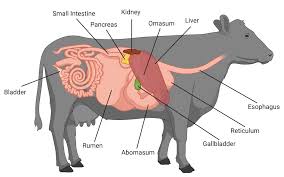The performance and utilization of plant materials by ruminant animals for production function is related to the efficiency of their gastro- intestinal tract. The handling of food materials by ruminant animals and subsequent digestive process differ largely from that of non-ruminants. The gastro-intestinal tract starts from the mouth of the animal.
The cheeks form a wall at the two sides of the mouth with the tongue as the soft organ beneath, the hard palate above it and is partially separated from the pharynx.
The door of the mouth are the lips which in cattle are somehow stiff and not very flexible while the lips in sheep and goats are more flexible and helps in picking feed faster than in cattle.
A good understanding of the digestive system of ruminant based on its anatomy is a key factor for successful ruminant production.
1. Digestion in the Mouth and Oesophagus
The whole process of digestion starts from the mouth of the animal. The combination of the tongue and the lips help ruminant animals to pick and roll the plant material into the mouth. The teeth helps in the mastication or chewing of the plant material.
There are two types of dentition in ruminants. The first is called deciduous dentition which is found in young animals with formular I 0/4; C 0/0; P 3/3. The second is called the permanent dentition with formular I 0/3; C 0/3; P 3/3; M 3/3 where I = Incissors, C= Cannine, P= Premolar and M= Molar.
The mouth has salivary gland that secret saliva with pH of about 8.2. It stabilizes the pH of the mouth and reduces the acidity in the subsequent chamber called the rumen.
The oesophagus is a tubular column through which food is swallowed and regurgitated for re-chewing. It has no sphincter valves and the muscles contracts in both direction to allow movement of food.
2. Digestion in the Stomach
The stomach forms the greater proportion of the ruminants’ digestive system. It has four chambers. The first is the rumen, while the second is reticulum, omasum is the third and abomasum the fourth.
3. Digestion in the Rumen and Reticulum
The digesta move through the oesophagus into the rumen. A thin wall separate the rumen and the reticulum and the contents always mix. Hence the two chambers is called reticulorumen. It is in the rumen that fermentation of the plant materials takes place. The rumen harbours billions of microbes for this function.
Read Also : Weed Control Methods for Plantain Plantations
In the young and unweaned animal, there exist an oesaphageal groove that enables the milk ingested to pass down into the abomasum which is the true stomach for digestion and subsequent absorption and utilisation in the small intestine.

4. Digestion in the Omasum
After fermentation, the digesta flows into the omasum chamber. The omasum is a spherical organ with muscular laminae and in this chamber, water and inorganic minerals are absorbed. The digesta is filtered to ensure that no harmful object enters into the omasum.
5. Digestion in the Abomasum
This the true stomach and the first glandular portion whereby digestion by enzymes take place. Gastric juice containing hydrochloric acid, pepsin, renin and lipase are produced.
In young unweaned animals, the abomasum is about 80% of the stomach while in the adult it is only 10%. The digesta stays in the abomasum for about 1-2 hours
6. Digestion in Small Intestine
Further breakdown of the food digesta occur at the upper part of the small intestine. Here, pancreatic juice and bile assist in the digestion process while absorption of the end product takes place in the lower portion of the intestine through a finger-like structure called villi.
7. Digestion in the Large Intestine
The large intestine is made up of the colon and caecum. In this part of the Gastro-Intestinal Tract (GIT), some of the food residue are deposited for further fermentation in the caecum which has a blind end containing some microbes.
The absorption of water and other nutrients continues in the colon. The digesta moves until it reaches the rectum and anus. The undigested food material forms a solid mass in the colon and it is eventually expelled through the anus.
In summary, the digestive system of ruminants is made up of the mouth, the oesophagus, the four compartmental stomach (rumen, reticulum, omasum and abomasum), the small intestine and the large intestine.
Fermentation of the plant material occurs in the rumen which harbor billions of microorganism that attack fibre for proper nutrient utilization. The abomasum is the true stomach where digestion takes place.
Absorption of water, inorganic mineral and nitrogen takes place in the omasum and also in the small intestine, the colons and large intestine.
Read Also : Bulky Wastes Complete Management Guide

